HAROLD CAZNEAUX 1878-1953
an exhibition at the AGNSW 30 August - 28 September 1975
Originally published as brochure for the 1975 AGNSW exhibition
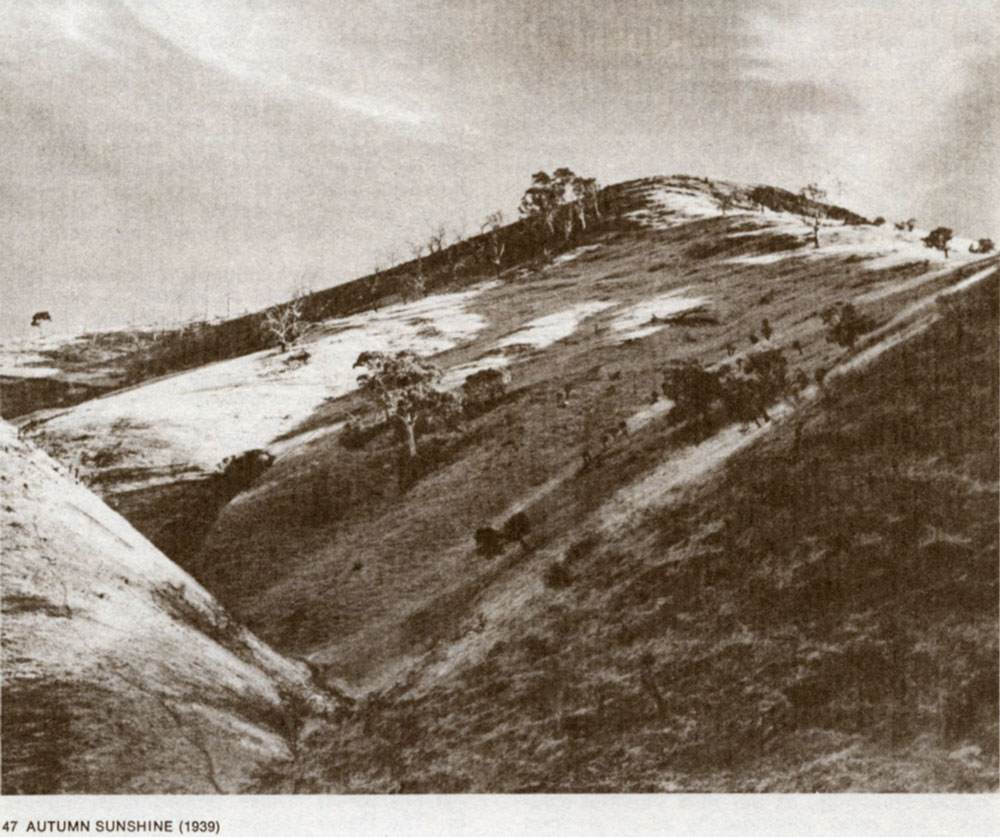
Harold Cazneaux, known as "Caz" in photographic circles was, like his nickname, modest and quiet. However, his life was firmly dedicated to a conviction that the photograph could be a vehicle of creative personal expression. He proudly considered himself an artist with a camera.
This Project exhibition of a small selection of Cazneaux's work is the first exhibition of an Australian photographer's work in the Art Gallery of New South Wales. The exhibition is intended as a reminder of an artist whose reputation as a major Australian photographer was undisputed in his lifetime, but whom the public has perhaps forgotten in the two decades since his death.
Cazneaux's friendship with the artists of the day, his contribution as the official photographer to "The Home" and "Art in Australia" magazines and the consistent quality of his work assures his place in any consideration of early 20th century Australian art.
BIOGRAPHY
Harold Cazneaux was born in Wellington, New Zealand, in 1878 where his parents operated a photographic studio. In the early 90's the Cazneaux family returned to Australia where his father, Pierce Mott Cazneaux, managed Townsend Duryea's studio before settling in Adelaide at Hammer & Co. Studios.
Cazneaux when about 18 years old began work as a retoucher in the Hammer & Co. Studio. However, photography at that time was not the outlet for his creative talents or for his early appreciation of nature:
"The retouching business in a little stuffy room in the noisy awful city was odious to me for a long time. Many a time I rebelled and banged the negatives across the room — I wanted to live in the bush always. . . ."
Cazneaux cherished early notions of being a painter and had always sketched. He attended evening art classes at the Adelaide School of Design under H. P. Gill, who also taught Hans Heysen.
It appears that Cazneaux's conversion to photographic art was effected by the single event of a chance visit in 1898 to the first Australian exhibition of what is known as "Pictorial photography", organized by the South Australian Photographic Society. In particular Cazneaux was impressed by the work of John Kauffman (1868-1947) an Adelaide architect, who had recently travelled overseas and come in contact with new trends in the recognition of the artistic, as opposed to documentary possibilities of photography. Kauffman returned in 1897 and brought with him examples of work by H. P. Robinson, Horsley Hinton and other leading exponents of the Pictorial movement.
The Pictorial movement in photography was largely characterised by prints manipulated to render them less realistic and more painterly and picturesque. The photographer could be an artist by his control of the mechanical processes of photography. The new printing techniques of gumbichromate, carbon, and bromoil (introduced 1894-1907), enabled the photographer to alter the image's tones and details. Pictorial photographs tended to be sombre in tone, with soft focus giving the photograph the appearance of an etching in the style of Rembrandt or a lithograph.
Cazneaux was an immediate convert to the idea of the controlled photograph as a means of personal and creative expression: "I stood spellbound and inspired, here was a new beauty beyond anything I had dreamed of in terms of the camera." The 1898 exhibition had contained views of old Sydney and for this potential source of subject matter, and to better his financial position, Cazneaux moved to Freeman's Studio in Sydney. He was to spend fourteen years there and became Chief Operator (as his father had been prior to opening his own studio in New Zealand).
Whilst at Freeman's, Cazneaux ordered a camera better suited to his interest in outdoor work. It was the new "Midge" quarter-plate box camera which did not require a heavy tripod. The wet plate era of cumbersome gear had passed, and the dry plate and roll film meant photography could move out of the studio. In his free time, Cazneaux began his personal photography, exploring the docks area of old Sydney as well as the surrounding bushlands. In 1905 he married Mabel Winifred Hodge, from Hammer Studio, and the following year he joined the Photographic Society of New South Wales. Cazneaux made friends with fellow creative photographers such as Cecil Bostock, Monte Luke, Norman Deck and James Paton.
Cazneaux's production was prolific under the inspiration of Pictorial photography. In 1907, he exhibited at the Photographic Society of New South Wales and by 1909, his eminence in the field was recognised by the Society's request for a one-man show of his work. It was Australia's first one-man photography show and was held in the Society Rooms in Hamilton Street, Sydney. A catalogue was produced and the show was as well received, and as influential, as the 1898 Pictorial exhibition had been.
Photography as an art form was recognised by press and public and for Cazneaux a career of lecturing, judging, and writing was to follow. Prints from the exhibition were sent to the London Salon, beginning a long period of overseas success for him. H. Snowden Ward, the prominent critic of the time, wrote of his work at the London Salon: "In one stride Harold Cazneaux comes from the position of a very good man indeed, to rank with the few outstanding workers of the world in pictorial photography. I place him with the dozen or more of the pioneers from whom one can expect anything of note."
In 1916 to further develop Pictorial photography, Cazneaux and Cecil Bostock initiated the Sydney Camera Circle. It was an informal group of a dozen or so of the best pictorial photographers who met once a month to discuss each other's work. Membership was by invitation, and standards were very high. In 1917, Cazneaux suffered a breakdown from overwork and upon recovery he resigned from Freeman's to set up his own studio.
For a while he used Cecil Bostock's studio in Den-man Chambers. It was here that Sydney Ure Smith saw Cazneaux's prints and as a result offered him the position of official photographer to "The Home" and "Art in Australia" magazines, which he and Bertram Stevens were about to launch as the most sophisticated high quality publications yet seen in Australia.
The new job provided Cazneaux with freedom to work in his own style and financial security. From 1920 he worked from his Roseville home assisted by his wife and daughters. Though Cazneaux was not employed full time by "The Home" and was thus able to work as a freelance photographer, his association with "The Home" and "Art in Australia" from 1920-41 provided the impetus for his most interesting and varied work. |
|
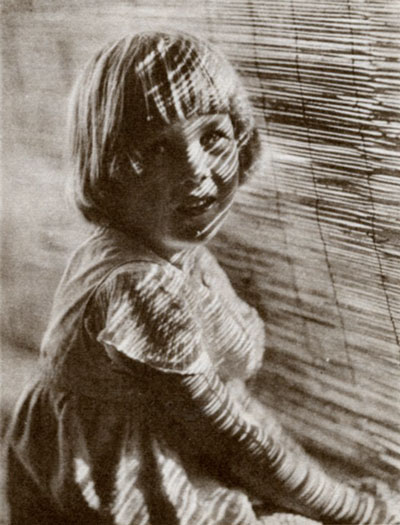 |
| |
12 The Bamboo Blind (1915) |
Prior to 1920 Cazneaux's reputation was largely based on his documentary views of old Sydney and picturesque landscape work. During the period 1920-41 his range of subject matter was extended because of the variety of "The Home" assignments which included fashion illustrations, architectural and garden studies, society portraits, current interests such as surfing and landscapes to satisfy the interest of the period in Australiana. Cazneaux was able to move with ease from one subject to another and made little distinction between creative and commercial work. He developed new stylistic approaches appropriate to these varied subjects.
"The Home" deliberately aimed at being "modern" and the layouts of the 20's featured the current Art Deco style. Cazneaux's interest in novel composition and pure design, evident in "The Razzle Dazzle" of 1908 (cat. no. 2), was developed in the "Wheel of Youth" (1929-34, cat. no. 29). In 1929 he worked on a series of pure Art Deco exercises; these were the "New Idea Portrait" series (see Doris Zinkeisen cat. no. 19) which were produced in collaboration with painters of the day, Roy de Mestre (later spelt de Maistre), Adrian Feint and George Lambert who painted backdrops for the portraits.
Being free to work outdoors with natural light, Cazneaux developed an interest in exploiting the design potential of striped and dappled patterns of sunlight. The first issue of "The Home" (1920) featured "The Bamboo Blind" (cat. no. 12), a novel essay in portraiture and abstract patterns which was one of Cazneaux's best known pictures. A series of sunlight pattern subjects followed including: "Pergola Pattern" (cat. no. 22), and the entries for "The Home Social Photograph" competition of 1931. Cazneaux won first, second and third prizes.
The winning picture was "Sun Portrait" (cat. no. 23). These pictures revitalized the portrait photograph and suggested new graphic possibilities in photography in line with overseas trends seen in the photographs of the Man Ray and the Bauhaus school. Cazneaux was at last able to make extended trips to the country areas. The Adelaide Hills and Flinders Ranges were visited between 1935-37, and these trips produced a series of landscape studies with a new feeling for clear Australian sunlight and space, involving a majestic interpretation of the landscape (see cat. nos. 38-41).
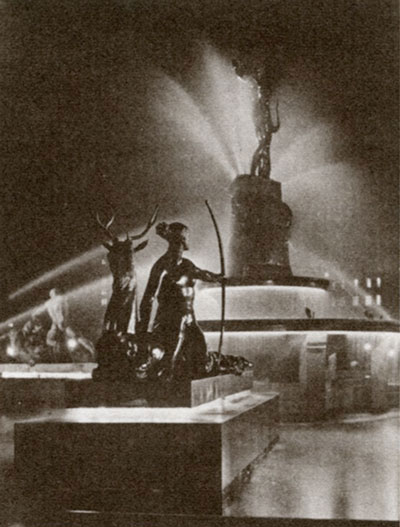 |
|
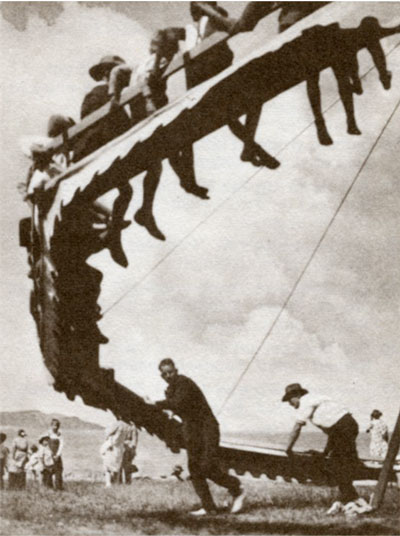 |
| 33 Diana, Archibald Fountain At night (1933) |
|
29 The Wheel of Youth (1929-1934) |
These photographs, featured in "The Home Annuals" (1935-38), expressed the interest of the time in subjects which were characteristically Australian, and can be compared with paintings of the period by artists such as Heysen and Margaret Preston. One of the best known photographs of this period was the "Spirit of Endurance" (cat. no. 41) which captured a feeling of the mysterious, rugged independence of the gum, which is now known as the "Cazneaux Tree".
While Cazneaux was exploring these pictorial possibilities in the 20's-30's, he was also using the Bromoil process so popular with Pictori-alists overseas. Many of the old Sydney views were reprinted in the new process which well suited the nostalgic subject matter. Cazneaux was an expert in the use of the Bromoil technique and could obtain any effect desired. The process, with its soft focus and broad tonal range could be used to make country scenes such as "Barnyard" (cat. no. 18) or "Old Sofala" (cat. no. 17), charmingly "old world", yet in other photographs such as "The Far Flung Ranges of the Flinders" (cat. no. 39) the strength of the subject is retained despite the softness of the print.
Apart from his work for "The Home", "The Home Annual" and "Art in Australia", Cazneaux's publications included the special editions of "Art in Australia", "The Koala Bear Books", "The Frensham Book". Other publications included the "Sydney University Book", "Domestic Architecture in Australia", "Sydney Surfing", "Australia Beautiful" and "Treescapes".
The Special Jubilee Book of B.H.P., covering the works of Whyalla, Newcastle and Iron Knob provided Cazneaux with an exercise in Industrial Photography to which he brought his fine sense of design and atmosphere (see cat. no. 42)
Cazneaux's friends included leading artists of the time. Arthur Streeton wrote in the introduction for "Treescapes": "His choice of subjects, his splendid instinct for design and light and shade, certainly puts him as an artist above many of our painters.
No one has presented trees in any way comparable, with those in his prints. He is a landscape man of the first order. He has a great gift."
Harold Cazneaux's work is characterized by a selection of a strong and arresting composition at the time of exposure and meticulous printing to achieve the exact tonal qualities desired. Pictures like "The Wheel of Youth" depend on the choice of an exact moment when all the elements are in the desired arrangement. Cazneaux's expertise with the Bromoil process allowed for precise control of tones and details as in "Sheep Tracks" (cat. no. 46) where a barbed wire fence in the foreground was removed to create a more effective composition. The reaction against Pictorialists accounts for a present day rejection of such manipulation. However, Caz-neaux would not have sympathized with this attitude as he regarded the final picture as the only criterion.
In 1938, Cazneaux was awarded the "Honorary Fellowship" of the Royal Photographic Society in London, the highest award made to an Australian photographer. In October 1952, The Sydney Camera Circle organized a testimonial evening for him as a tribute to his position in Australian Photography. Cazneaux kept working until his death at the age of 75 in 1953.
Exhibition organized by Gael Newton.
Special thanks are due to Rainbow Johnson, Carmen Field and Daniel Thomas for their assistance with the exhibition.
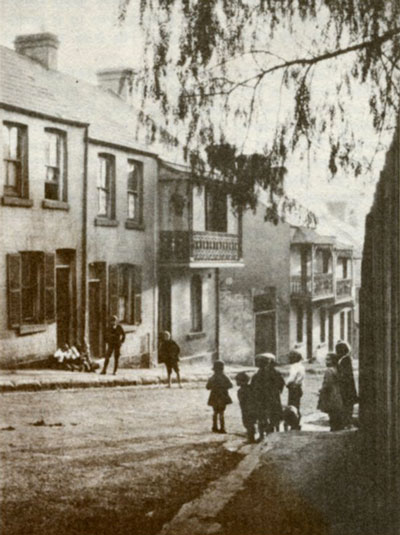 |
|
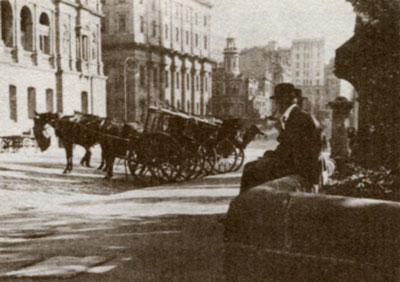 |
| 6 A Surry Hills Alleyway 1911 |
|
1 Cabbie (1904) |
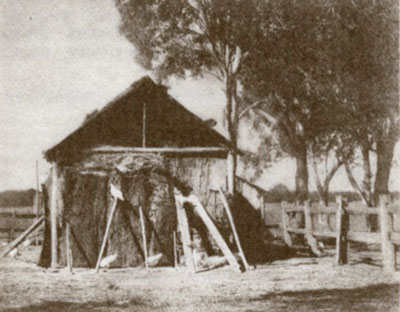 |
|
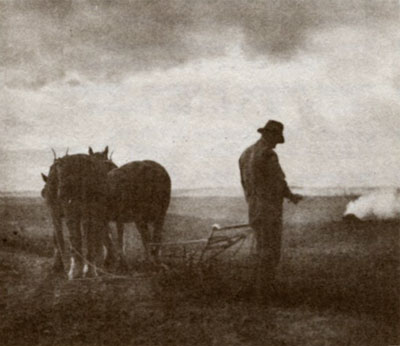 |
| 18 Barnyard (1920-1930) |
|
14 Peace After War and Memories (1916) |
CATALOGUE
All works are on loan from the late Harold Cazneaux's daughters, Mrs. Rainbow Johnson, Mrs. Eric Blundell, Miss Beryl Cazneaux, Mrs. Vincent Field and Mrs. Herbert Smith. Dates are where possible attributed to the time of actual taking as prints were often made from the negative at a much later date. Cazneaux often reprinted early negatives in the Bromoil process which he began using around 1920.
Bromoil refers to a process whereby a bromide print could be bleached and the remaining image which was in relief could pick up printer's ink or oil. Light and dark areas could be controlled and undesirable detail eliminated.
Measurements are in centimetres, height then width
- Cabbies (1904). 17.6x23.5 cm. Signed, titled. Chloro/bromide.
- Razzle Dazzle 1908. 22.4 x 28.4 cm. Signed, titled, dated. Chloro/bromide.
- Wharfies Circular Quay (1910). 23.5 x 27.5 cm. Chloro/bromide.
- Bound East (1910). 23.2 x 15 cm. Signed, titled. Bromide.
- The Quest (1910). 22.6x17.6 cm. Signed. Bromoil. Subject: Rainbow Cazneaux.
- A Surry Hills Alleyway 1911. 26 x 20.2 cm. Signed, titled, dated. Bromide.
- Washing Pattern Woolloomooloo (1910-1912). 25.3x15 cm. Bromoil.
- Timber Floating in Sydney Harbour (1910-12). 15.1x21.1 cm. Bromoil.
- Lumber Mill Camden (1910-12). 18.3x14.4 cm. Titled, signed. Bromoil.
- Pavement Artist 1914. 21.8 x 22 cm. Signed, titled, dated. Chloro/bromide.
- The Orphan Sisters (1914). 19.5x23.5 cm. Titled, signed. Chloro/bromide. Subject: Florrie and Lil Peisley.
- The Bamboo Blind (1915). 27.8 x 21.2 cm. Signed, titled. Bromide.Subject: Daughter Beryl. Serious version.A smiling version appeared in the first issue of "The Home Magazine" (1920, Vol. 1, No. 1).
- The Bent Trees (1915). 27x35.2 cm. Signed, titled. Chloro/bromide.
- Peace after War and Memories (1918). 26.2x32.2 cm. Signed. Chloro/bromide.
- Black Horses (1920-30). 17.2x21.5 cm. Signed, titled. Bromoil.
- Old Sofala (1920-30). 16x20.7 cm. Signed, titled. Bromoil.
- Sunday (1920-30). 14.6x20 cm. Signed, titled. Bromoil.
- Barnyard (1920-30's). 17.1 x 21.3 cm. Signed, titled. Bromoil.
- Doris Zinkeisen (1929). 31.6x19.5 cm. Bromide. A version of the "New Idea Portrait" series for "The Home" (1928-9), Cazneaux's portrait with backdrop painted by Adrian Feint. Subject: Mrs. Graham Johnstone.
- Sydney Surfing (1920-30). (Coogee Beach, N.S.W.) 23.4x15.1 cm. Bromide.
- Beach Scene (1929-30). (Bondi Beach, N.S.W.) 31.9x15.1 cm. Chloro/bromide.
- Pergola Pattern (1931). 34.5 x 25.4 cm. Kodura etching brown paper. Subject: Daughter Beryl.
- Sun Portrait (1931). 26.4 x 22 cm. Signed, titled. Subject: Miss Lesley Sugden. The Winning Portrait in "The Home Social Photograph Competition". Chloro/bromide.
- Miss Dorothy Gadsby (1931). 27.3x21.5 cm. Chloro/bromide print. An entry for "The Home Social Photograph Competition".
- Margaret Vyner (1931). 28.7 x 22.5 cm. Chloro/bromide. A version of the entry in "The Home Social Photograph Competition".
- Sydney Bridge (1933). 29.6x21.4 cm. Signed, titled. Chloro/bromide.
- The Road Up the Hill (1935-37). (Finders Ranges.) 17.2x27.7 cm. Signed, titled. Chloro/bromide.
- Landscape N.S.W. (1935-40). 23 x 32 cm. Signed, titled. Bromoil.
- The Wheel of Youth (1929-34). 34 x 28 cm. Signed, titled, dated 1929. (Elsewhere 1934.) Chloro/bromide.
- Dry Weather (1929). 17.5x24 cm. Signed, titled. Chloro/bromide.
- Riverside Nepean (1930). 33.2 x 25.5 cm. Signed, titled. Bromide.
- Bush Fire Haze (1932). (Mt. Talbingo, N.S.W.) 29x22.6 cm. Bromoil.
- Diana (1933). (Archibald Fountain at night.) 39 x 32 cm. Bromide.
- Archibald Fountain at Night, Sydney (1933). (Theseus). 24.5 x 30.5 cm. Signed, titled. Chloro/bromide.
- Georgian Landscape (1930-5). 36.5x26.7 cm. Signed, titled. Bromide.
- The Glade (1935). 28.5 x 37 cm. Signed, titled. Bromoil.
- Wayside Grasses (1935-7). 24.7x22.5 cm. Bromoil.
- The Folded Hills, S.A. (1935). (Adelaide Hills.) 25.5x33.5 cm. Signed, titled. Bromoil.
- Far Flung Ranges of the Flinders (1935). (Flinders Ranges.) 26.8 x 34 cm. Bromoil.
 The Shadowed Hills (1935). (Flinders Ranges.) 27x37 cm. Chloro/bromide. The Shadowed Hills (1935). (Flinders Ranges.) 27x37 cm. Chloro/bromide. - The Spirit of Endurance (1937). (North Wilpena, Flinders Ranges.) 37.7 x 39 cm. Signed, titled. Chloro/bromide.
- Rolling Steel Plates B.H.P. Pty. Co. Ltd. (1935). 30x35 cm. Signed, titled. Chloro/bromide.
- Wheels (1935). (Despatch bay, tramway wheels and axles.) 22.3 x 23.9 cm. Signed, titled. Chloro/bromide.
- Departure (1936). 28.7 x 30.6 cm. Bromoil.
- River Gums (1935-7). (Melrose, S.A.) 28.7x33.6 cm. Chloro/bromide.
- Sheep Tracks (1936-7). 32 x 22.5 cm. Bromoil.
- Autumn Sunshine (1939). 27.3 x 33.5 cm. Signed, titled. Chloro/bromide.
click here for Harold Cazneaux main introduction page
more of Gael Newton's Essays and Articles
|







